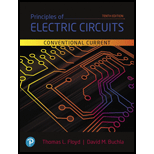Solutions for Principles Of Electric Circuits
Problem 1RP:
Express 4,750 in scientific notation.Problem 2RP:
Express 0.00738 in scientific notation.Problem 3RP:
Express 9.12 103 as a regular decimal number.Problem 4RP:
Add 3.1 103 and 5.5 104.Problem 5RP:
Subtract 3.5 106 from 2.2 105.Problem 6RP:
Multiply 3.2 106 and 1.5 103.Problem 7RP:
Divide 8 106 by 2 1010.Problem 8RP:
Express 36,000,000,000 in engineering notation.Problem 9RP:
Express 0.0000000000056 in engineering notation.Problem 10RP:
Express using metric prefixes: 1. 56,000 2. 0.000470 AProblem 11RP:
Convert 1 mA to microamperes.Problem 12RP:
Convert 1,000 mV to millivolts.Problem 13RP:
Convert 893 nA to microamperes.Problem 14RP:
Convert 10,000 pF to microfarads.Problem 15RP:
Convert 0.0022 mF to picofarads.Problem 16RP:
Convert 2.2 k to megohms.Problem 2TFQ:
The base electrical unit in the SI system is the volt.Problem 3TFQ:
The supplementary SI units are for angular measurements.Problem 5TFQ:
A negative number that is expressed in scientific notation will always have a negative exponent.Problem 6TFQ:
When you multiply two numbers written in scientific notation, the exponents need to be the same.Problem 7TFQ:
When you divide two numbers written in scientific notation, the exponent of the denominator is...Problem 10TFQ:
0.047 F is equal to 47 nFProblem 11TFQ:
0.010 F is equal to 10,000 pF.Problem 12TFQ:
10,000 kW is equal to 1 MW.Problem 15TFQ:
When you apply the round-to-even rule to round off 26.25 to three digits, the result is 26.3.Problem 17TFQ:
The base SI electrical unit is the ampere.Problem 1ST:
Which of the following is not an electrical quantity? a. current b. voltage c. time d. powerProblem 4ST:
An mks measurement unit is one that a. can be expressed as a combination of the meter, kilogram and...Problem 5ST:
In the Sl system, the prefix k means to multiply the unit by a. 100 b. 1,000 c. 10,000 d. 1,000,000Problem 11ST:
Five thousand volts can be expressed as a. 5,000 V b. 5 MV c. 5 kV d. either answer (a) or (c)Problem 14ST:
When reporting a measured value, it is okay to include a. the entire result as shown on a calculator...Problem 1P:
Express each of the following numbers in scientific notation: a. 3,000 b. 75,000 c. 2,000,000Problem 2P:
Express each fractional number in scientific notation a. 1/500 b. 1/2,000 c. 1/5,000,000Problem 3P:
Express each of the following numbers in scientific notation: a. 8,400 b. 99,000 c. 0.2 106Problem 4P:
Express each of the following numbers in scientific notation: a. 0.0002 b. 0.6 c. 7.8 102Problem 5P:
Express each of the following numbers in scientific notation: a. 32 103 b. 6,800 106 c. 870 108Problem 6P:
Express each of the following as a regular decimal number: a. 2 105 b. 5.4 109 c. 1.0 101Problem 7P:
Express each of the following as a regular decimal number: a. 2.5 106 b. 5.0 102 c. 3.9 101Problem 9P:
Add the following numbers: a. (9.2 106) + (3.4 107) b. (5 103) + (8.5 101) c. (5.6 108) + (4.6 ...Problem 11P:
Perform the following multiplications: a. (5 103)(4 105) b. (1.2 1012)(3 102) c. (2.2 109)(7 ...Problem 13P:
Perform the indicated operations: a. (8 104 + 4 103) 2 102 b. (3 107)(5 105) 9 1012 c. (2.2 ...Problem 14P:
Starting with 1012, list the powers of ten in increasing order used in engineering notation.Problem 15P:
Express each of the following numbers in engineering notation: a. 89,000 b. 450,000 c....Problem 19P:
Add the following numbers and express each result in engineering notation: a. (2.5 103) + (4.6 ...Problem 20P:
Multiply the following numbers and express each result in engineering notation: a. (32 103)(56 ...Problem 21P:
Divide the following numbers and express each result in engineering notation: a. 50 (2.2 103) b....Problem 24P:
Express each of the following as a quantity having a metric prefix: a. 31 103 A b. 5.5 103 V c. 20...Problem 27P:
Express each quantity by converting the metric prefix to a power-of-10: a. 7.5 pA b. 3.3 GHz c. 280...Problem 29P:
Perform the indicated conversions: a. 5 mA to microamperes b. 3,200 W to milliwatts c. 5,000 kV to...Problem 30P:
Determine the following: a. The number of microamperes in 1 milliampere b. The number of millivolts...Browse All Chapters of This Textbook
Chapter 1 - Quantities And UnitsChapter 2 - Voltage, Current, And ResistanceChapter 3 - Ohm's LawChapter 4 - Energy And PowerChapter 5 - Series CircuitsChapter 6 - Parallel CircuitsChapter 7 - Series-parallel CircuitsChapter 8 - Circuit Theorems And ConversionsChapter 20 - Time Response Of Reactive Circuits
Sample Solutions for this Textbook
We offer sample solutions for Principles Of Electric Circuits homework problems. See examples below:
More Editions of This Book
Corresponding editions of this textbook are also available below:
Principles Of Electric Circuits: Electron Flow Version
3rd Edition
ISBN: 9780023385018
Principles of Electric Circuits: Conventional Current Version
7th Edition
ISBN: 9780130995940
Principles Of Electric Circuits: Conventional Current Version-text Only
8th Edition
ISBN: 9780007705917
Principles Of Electric Circuits: Electron Flow Version
4th Edition
ISBN: 9780132310772
Electronic Devices (Conventional Current Version)
8th Edition
ISBN: 9780132429733
EBK PRINCIPLES OF ELECTRIC CIRCUITS
10th Edition
ISBN: 9780134879499
EBK PRINCIPLES OF ELECTRIC CIRCUITS
10th Edition
ISBN: 9780134880068
Principles Of Electric Circuits: Pearson New International Edition
9th Edition
ISBN: 9781292025667
Principles Of Electric Circuits: Electron Flow Version (9th Edition)
9th Edition
ISBN: 9780135073087
Principles Of Electric Circuits, 9ed
9th Edition
ISBN: 9789332573888
Principles Of Electric Circuits: Conventional Current Version And Lab Manual For Principles Of Electric Circuits: Conventional Flow Version Package (9th Edition)
9th Edition
ISBN: 9780137068258
Principles Of Electric Circuits: Electron Flow Version With Lab Manual (9th Edition)
9th Edition
ISBN: 9780135090824
Principles of Electric Circuits: Conventional Current Version
9th Edition
ISBN: 9780135073094
Related Electrical Engineering Textbooks with Solutions
Still sussing out bartleby
Check out a sample textbook solution.
